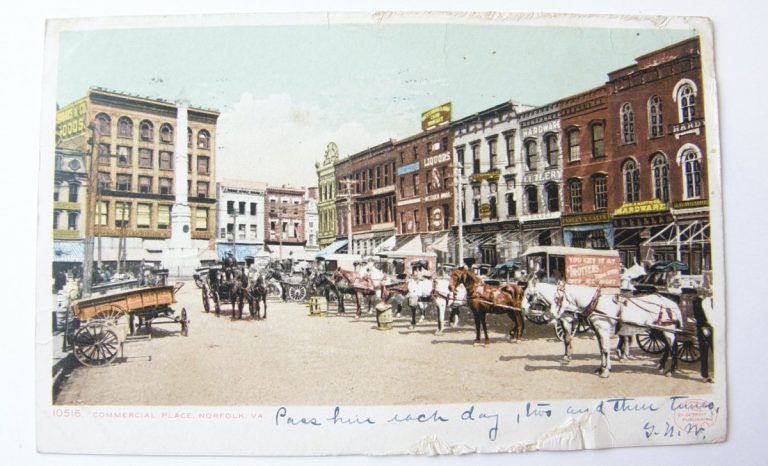V682:: Posted 1909, Street Scene, Commercial Space, Market Day, Norfolk Virginia, Commercial Signage, “You Get It At Trotter’s All Night”, Martin Hardware, Liquors, Horse-and-Buggies, Horse-drawn Wagons, Teamsters, White Horses, Publisher Unknown, Series Number 3033

SKU-V682::
Posted 1909, Street Scene, Commercial Space, Market Day, Norfolk Virginia, Confederate Monument, Commercial Signage, “You Get It At Trotter’s All Night”, Martin Hardware, Liquors, Horse-and-Buggies, Horse-drawn Wagons, Teamsters, White Horses, Market Square,
Publisher Unknown,
Series Number 3033,
FYI: “Norfolk is a waterfront city in southeastern Virginia. It’s home to Naval Station Norfolk, a massive naval base on Chesapeake Bay. Nauticus is a maritime museum that features the Battleship Wisconsin, a huge WWII warship. The Chrysler Museum of Art showcases a vast collection of glass art, plus European and American paintings and sculpture. The riverside Virginia Zoo is home to bears, birds, lions and farm animals.” (RE: Google).
“The Norfolk Confederate Monument is a towering columnn located in the center of Main Street, in the downtown area. The monument was created by Norfolk-born artist, William Couper. It commemorates the final meeting of surviving Confederate soldiers and honors the Norfolk-area Confederate forces who served in the American Civil War. The structure features a 15-foot bronze sculpture of a Confederate soldier atop a 50-foot pedestal. On January 28, 1898, the city government granted permission for the placement of the Confederate Monument in Commercial Place (formerly Market Square). Construction on the monument began in February 22 1898. The cornerstone was laid on the 32nd anniversary of the inauguration of Jefferson Davis as the President of the Confederate States of America. Unveiled on May 16, 1907, the Confederate Monument is designed in the neo-Classical style. The base is made from white, Vermont granite. In 1964/1965, the construction of the Bank of America Center resulted in the statue’s dismantlement out of concern that it would be damaged by pile drivers. Following a cleaning, it was relocated to its present location in 1971. In 2015, following a campaign by a local civil rights group to remove the monument, the City Council announced their intention to keep the monument in place. The city ignored the work of historians who demonstrated the need for more interpretation of monuments that were constructed in an effort to erase the history of Reconstruction and the South’s defeat. Perhaps ironically, several city council members expressed the view that removing the monument would be an attempt to erase history. Vice Mayor Angelia William Graves explained her defense of the monument in similar terms. “You can’t erase history just because you don’t like it,” Graves said. “It is what it is. To remove it would be a mistake.”
(RE: https://theclio.com/entry/29395)
USA 1909 c.Reference number: 2024.V682
Click here to print.
go back
